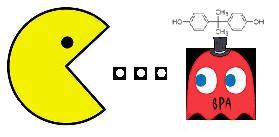We are the Caltech 2011 iGEM Team. We are interested in the bioremediation of endocrine-disrupting chemicals in bodies of water.
Endocrine-disrupting chemicals are substances which detrimentally effect the development and reproduction of wild organisms. These chemicals mimic natural biological estrogen in their interaction with animal estrogen receptors. This interaction has negative effects for reproductive processes of several species of fish and birds. To remedy that, the Caltech iGEM team hopes to engineer bacteria which can degrade DDT, synthetic estrogen (17a-ethynylestradiol), bisphenol A, and nonylphenol to less toxic forms. Compared to traditional forms of pollution removal, bioremediation is relatively cheaper and less disruptive to the environment. However, a successful project must make sure that the bacteria used for remediation do not act as pollutants or introduce toxic byproducts into the environment.
There are several standard methods of detection for endocrine disruptors to establish which bodies of water require bioremediation. One method involves examination of the local fish population for signs of male feminization, indicated by male expression of vitellogenin, a protein used in egg yolk. Another test developed by the EPA involves using human breast cancer cells containing genes that produce luciferase when an endocrine-disrupting chemical is detected. Once these tests establish the presence of a chemical that can interfere with estrogen receptors, we can use a degradation pathway to remove these chemicals from the body of water.
We explored many pathways for degradation. We created a genetic construct for E. coli containing the BisdA and BisdB proteins previously shown to degrade BPA and explored the efficacy of degradation using cell lysates. In addition, we constructed a gene optimized for producing the DDT dehydrochlorinase enzyme and characterized its efficacy at degrading our target chemicals. To do this, we mixed cell lysates of E. coli containing constructs designed to produce these degradation enzymes with our target endocrine disruptors, and then analyzed the results of these reactions using HPLC.
In addition to testing previously discovered degradation enzymes, we conducted a gene fishing experiment using samples from the LA river. We selected the LA river because it has previously been shown to contain a high level of plastic pollutants, so it is possible that some selection has already occurred in the river for bacteria that can degrade plastics. We grew up these samples in minimal media containing our target chemicals as the sole carbon source, and transferred each sample to new minimal media in a progressive selection process. When we plated the final transfers on LB plates, we saw colony growth, indicating that some bacteria were able to survive using endocrine disruptors as a carbon source and thus have a method for degrading these chemicals.
To investigate the feasibility of using E. coli genetic constructs to perform a reaction on large bodies of water we also prepared biofilms of E. coli on glass beads and prepared columns to test the concept using beta-galactosidase to degrade X-gal. In addition, we visited three different water treatment plants to learn about the methods they used for removing different pollutants from water and how bioremediation can integrate into these systems.

 "
"


